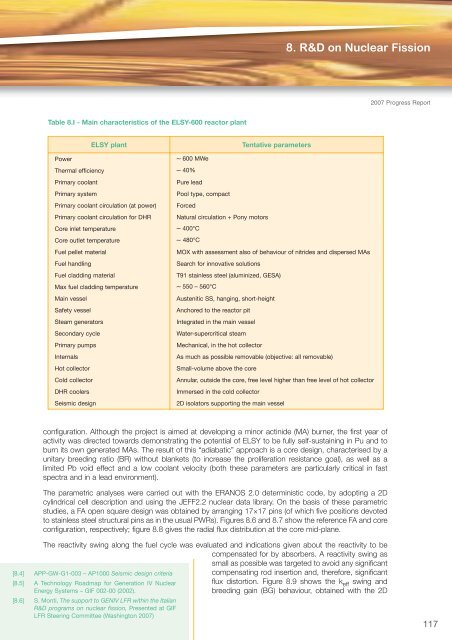Fusion Programme - ENEA - Fusione
Fusion Programme - ENEA - Fusione
Fusion Programme - ENEA - Fusione
- No tags were found...
Create successful ePaper yourself
Turn your PDF publications into a flip-book with our unique Google optimized e-Paper software.
8. R&D on Nuclear Fission2007 Progress ReportTable 8.I - Main characteristics of the ELSY-600 reactor plantELSY plantTentative parametersPower∼ 600 MWeThermal efficiency ∼ 40%Primary coolantPure leadPrimary systemPool type, compactPrimary coolant circulation (at power) ForcedPrimary coolant circulation for DHR Natural circulation + Pony motorsCore inlet temperature ∼ 400°CCore outlet temperature ∼ 480°CFuel pellet materialMOX with assessment also of behaviour of nitrides and dispersed MAsFuel handlingSearch for innovative solutionsFuel cladding materialT91 stainless steel (aluminized, GESA)Max fuel cladding temperature ∼ 550 – 560°CMain vesselAustenitic SS, hanging, short-heightSafety vesselAnchored to the reactor pitSteam generatorsIntegrated in the main vesselSecondary cycleWater-supercritical steamPrimary pumpsMechanical, in the hot collectorInternalsAs much as possible removable (objective: all removable)Hot collectorSmall-volume above the coreCold collectorAnnular, outside the core, free level higher than free level of hot collectorDHR coolersImmersed in the cold collectorSeismic design2D isolators supporting the main vesselconfiguration. Although the project is aimed at developing a minor actinide (MA) burner, the first year ofactivity was directed towards demonstrating the potential of ELSY to be fully self-sustaining in Pu and toburn its own generated MAs. The result of this “adiabatic” approach is a core design, characterised by aunitary breeding ratio (BR) without blankets (to increase the proliferation resistance goal), as well as alimited Pb void effect and a low coolant velocity (both these parameters are particularly critical in fastspectra and in a lead environment).The parametric analyses were carried out with the ERANOS 2.0 deterministic code, by adopting a 2Dcylindrical cell description and using the JEFF2.2 nuclear data library. On the basis of these parametricstudies, a FA open square design was obtained by arranging 17×17 pins (of which five positions devotedto stainless steel structural pins as in the usual PWRs). Figures 8.6 and 8.7 show the reference FA and coreconfiguration, respectively; figure 8.8 gives the radial flux distribution at the core mid-plane.The reactivity swing along the fuel cycle was evaluated and indications given about the reactivity to becompensated for by absorbers. A reactivity swing assmall as possible was targeted to avoid any significant[8.4] APP-GW-G1-003 – AP1000 Seismic design criteria[8.5] A Technology Roadmap for Generation IV NuclearEnergy Systems – GIF 002-00 (2002).[8.6] S. Monti, The support to GENIV LFR within the ItalianR&D programs on nuclear fission, Presented at GIFLFR Steering Committee (Washington 2007)compensating rod insertion and, therefore, significantflux distortion. Figure 8.9 shows the k eff swing andbreeding gain (BG) behaviour, obtained with the 2D117













